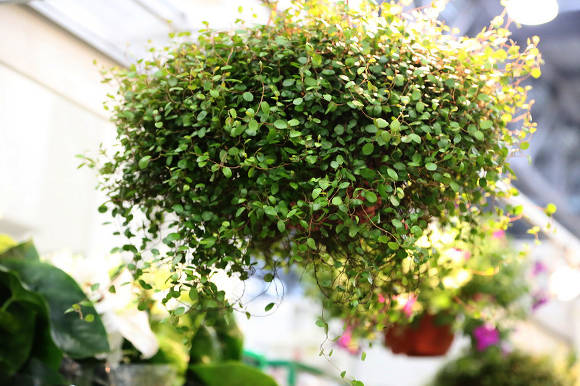
Müllenbeckia matted, or embracing, is an unpretentious houseplant that forms a scattering of small round leaves against a background of thin, woven brown shoots. It can be shaped into a ball in a hanging basket or run over a support to create a gorgeous green shape.
For thin, curly, wavy shoots, the people call it the Wirevine, Liana of girl's hair.
And although this plant can bloom with small greenish-cream axillary flowers, they are of interest mainly for their aroma, therefore the plant is considered more ornamental-deciduous. It can be placed both indoors and in cool conservatories. This is one of the few shade-tolerant plants.
Description of the plant - on the Müllenbeckia page.
Priming... For mullenbeckia, a universal potting soil containing perlite is suitable. It can be independently made from sod land: leafy earth: sand in a ratio of 1: 2: 1. The optimum acidity is from acidic to neutral (pH 5.0-7.0).
Transfer... It is advisable to transplant muhlenbeckia every year in the spring in March-April, if the pot is small, and once every 2-3 years, if the dishes are large enough for it. The size of the pot during transplantation is increased slightly - by only 2-3 cm. The plant does not tolerate trauma to the roots during transplantation, so it is better not to transplant adult specimens, but to transfer them. In those years when the transplant is not carried out, replace the top 5 cm of soil with a fresh one, with the addition of Biohumus.
- Soils and soil mixtures for indoor plants
- Transplanting indoor plants
Lighting... Müllenbeckia is an excellent shade-tolerant plant. This is one of the few indoor plants that prefer a shaded area. Its placement at a distance of no more than 1 m from the eastern, western and, moreover, southern windows. Direct sunlight is destructive for her, they cause drying not only of the foliage, but also of the shoots. But you can't overdo it with a shadow either. In deep shade or on northern windows, the plant will become less decorative, lose the density of stems and leaves.
 |  |
Temperature... Mühlenbeckia grows better in cool room conditions, does not tolerate heat well, so the room must be ventilated. In summer, the plant is satisfied with the usual room temperature of about + 20 ° С, in winter - in the range of + 10 ... + 15 ° С. Mühlenbeckia does not like sudden changes in temperature, so you need to change the conditions gradually.
Watering... Watering muhlenbeckia should be abundant, with the topsoil drying out between waterings. However, in winter, when the plant falls into a dormant state and begins to partially lose leaves, it is necessary to reduce watering. Keep the soil slightly damp between waterings, without stagnant water to prevent roots from rotting. But make sure that the soil does not completely dry out, otherwise the leaves will fall off.
Read more in the article Watering rules for indoor plants.
Air humidity... Spraying a plant in order to increase air humidity is actively carried out in the summer, with water at room temperature. In winter, spray it carefully, only in case of severe dryness of the air.
Top dressing... You need to feed muhlenbeckia at least once a month, using special fertilizers for indoor plants. In the spring-summer period, you can feed it every 2 weeks, in the winter - occasionally.
Read more in the article Top dressing of indoor plants.
Dormant period... The plant does not have a pronounced dormant period. It comes involuntarily, due to low natural light, and lasts from October to February. During this period, the temperature of the content is gradually reduced, the intervals between waterings are slightly increased and they are rarely sprayed.
Bloom... Mühlenbeckia can bloom with very small flowers in August. Although they are subtle, you can enjoy their pleasant scent.
Pruning... Mullenbeckia does not need special pruning, but it tolerates it well and grows quickly. The stems are pruned to the desired length in spring and summer. You can also pinch the tips of the shoots to encourage branching to keep the plant lush and leafy.
Read more in the article Methods for the formation of indoor plants.
Pests... The greatest threat to muhlenbeckia is the spider mite.
Read more in the article Houseplant pests and control measures.

Reproduction of muhlenbeckia
Mühlenbeckia is propagated by division, cuttings, and also by seeds.
The division is carried out in the spring, when transplanting. Cutting succeeds well throughout the spring-summer period. Several cuttings are usually planted in a pot at once to achieve a quick decorative effect, although one cutting will eventually develop into a full-fledged plant. Cuttings root quickly, because the plant will often root itself at nodes where it touches the ground.
Read more in the article Cutting indoor plants at home.
Possible problems when growing muhlenbeckia
- In autumn, the plant partially loses its leaves. - this is a natural process for a semi-deciduous shrub;
- Leaves fall in spring or summer - due to overdrying or waterlogging of the substrate;
- Leaves turn yellow - this is due to heat or direct sunlight, usually in the summer, but in the absence of fertilizing, it may indicate the plant is starving;
- The plant does not bloom - due to a too shaded location or a low temperature regime that has not been maintained during the rest period.









